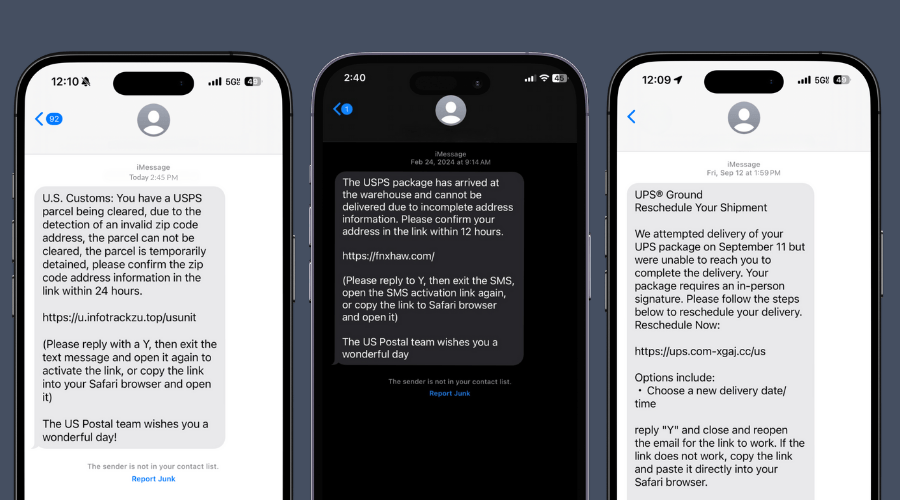
Contact Us
Bank Routing Number
107001481
Bank by Mail/General Mail
PO Box 26458
Kansas City, MO 64196
Deposit Only Mailbox
PO Box 26744
Kansas City, MO 64196
Phone Number
1-877-712-2265
Download our app
Access your
accounts here.
accounts here.

Grab your phone and scan the code to download!
featured
2025-10-03
Security
published
3-minute
Package Delivery Scams: Is This Delivery Text Real?

-
-
We have all been there... You are waiting on a package, and suddenly you receive this text or email: “Your delivery is on hold, click here to confirm your address.” Sound familiar? The growing popularity of online shopping has created a goldmine for package delivery scams. But how can you tell if a delivery text is real? And what should you do if you accidentally give your info to a fake delivery scam? Let’s break it down!
What is a Package Delivery Scam?
A package delivery scam is when a fraudster sends you a text or email while impersonating a delivery company (e.g., USPS, FedEx, UPS). The message typically claims you have a missed delivery, unpaid shipping fee, or problem with your package.
Since most of these scams happen through text messages, they fall into a specific fraud category known as “smishing” (SMS phishing). Their goal? To trick you into clicking a fake link that steals your personal information, login credentials, or even bank account details.
Real examples:

How Do I Know if a Delivery Text is Real?
It’s not always easy to spot the difference between real messages and fake ones, but package delivery scams typically have these red flags:
- Unsolicited Contact: The USPS does NOT send communications unless you have requested the service for a specific tracking number beforehand.
- Urgent Language: Scammers try to rush you with phrases like “immediate action required.”
- Request for Personal Information: Authentic delivery services will never ask for your personal or financial information to make a delivery.
- Poor Grammar or Spelling: Legitimate package services carefully proofread their messages. If you receive a notification that has errors or awkward phrasing, it’s a scam.
- Messages with Links: Legitimate FedEx and USPS text messages do not include links for tracking or payment updates.
PRO TIP: If you are asking yourself “Is this USPS text a scam?” or “How do I know if this UPS delivery notice is legit?” — trust your gut. It is probably fake.
What Happens if I Click on a Fake Package Delivery Link?
Clicking on a suspicious delivery link can cause serious problems because it impacts your cybersecurity. Here’s what happens specifically:
- Phishing Websites: The links take you to fake websites that closely mimic the sites of official delivery services.
- Compromised Personal Info: By interacting with the fake site or providing details, your personal and financial information can be taken and misused for identity theft, fraudulent accounts, and other scams.
- Malware Downloads: In some cases, clicking on the link can install harmful software to your device and steal sensitive data.
- Money Loss: If you enter your card or bank account details, scammers use that info to make unauthorized charges and take your money.
What Should I Do If I Gave My Info to a Fake Delivery Scam?
Accidentally clicked the link? Don’t panic but act quickly!
- Contact Bank: If you give out financial information, reach out to your bank immediately. Let them know what happened so they can monitor your account for fraudulent activity and help protect your money.
- Change Passwords: Update your passwords ASAP for the affected account. If you use that specific password on other sites or apps, make updates there as well.
- Monitor Financial Accounts: Keep a close eye on your bank statements, credit card transactions, and credit reports for any unusual activity. Check them regularly over the next few months (not all scammers act immediately).
- File Reports: To prevent this from happening to other victims in the future, make sure to file a report with the relevant parties, which we will cover next.
Where Do I Report a Package Delivery Scam?
By reporting to multiple agencies, it helps build a case against the scammers. File reports with:
- Delivery Services: Whether you received a UPS scam text link, a fake USPS delivery notice, or a FedEx scam email, you need to alert that carrier by sending a screenshot. (Contact Info: spam@uspis.gov, fraud@ups.com, abuse@fedex.com, phishing@dhl.com).
- Credit Bureaus: Contact Equifax, Experian, and TransUnion by placing a fraud alert on your credit file.
- Internet Crime Complaint Center (IC3): File a complaint at ic3.gov. This is the FBI’s official center for reporting internet fraud. Include details about the scam, any financial losses, and screenshots of suspicious messages.
- Federal Trade Commission (FTC): The FTC tracks scam patterns and protects consumers. You can report fraud at 1-877-FTC-HELP or reportfraud.ftc.gov.
- Academy Bank: If you are an Academy Bank client, report fraud by logging into Online Banking and sending us a secure message. You can also call our Client Care line at 877-712-2265 (Monday through Friday, 8:00 AM to 7:00 PM, Central Time) or visit a local banking branch (Find Academy Bank Near Me).
The Bottom Line on Package Delivery Scam Text Messages
Package delivery scams are everywhere, and cybercriminals are clever. But with a careful eye and quick action, you can protect yourself. Just remember:
- Think before you click.
- Report suspicious messages.
- When in doubt, visit the official carrier site directly.
- Reach out to Academy Bank if you think your financial information is at risk.
Trust your instincts! If something feels off, it probably is!
FRAUD PREVENTION: Scams & Fraud; Preventing ID Theft; Reporting ID Theft; Fraud Alerts & Freezes; Mobile Security Tips; Visa Card Security.
SCAM-SPECIFIC RESOURCES: Most Common Scams of 2025; Safe Checking Account Practices; Spoofing Attacks; Mail Theft & Check Washing; Investment in Crypto Scams; Phone Scams; Email Phishing Attacks; Text Message Scams; Phone Upgrade Security; SIM Swapping Scams; Payday Loan Scams; Business Fraud; Holiday Fraud Protection; Pig-Butchering Fraud; Elder Financial Abuse; Tax Season Security.



